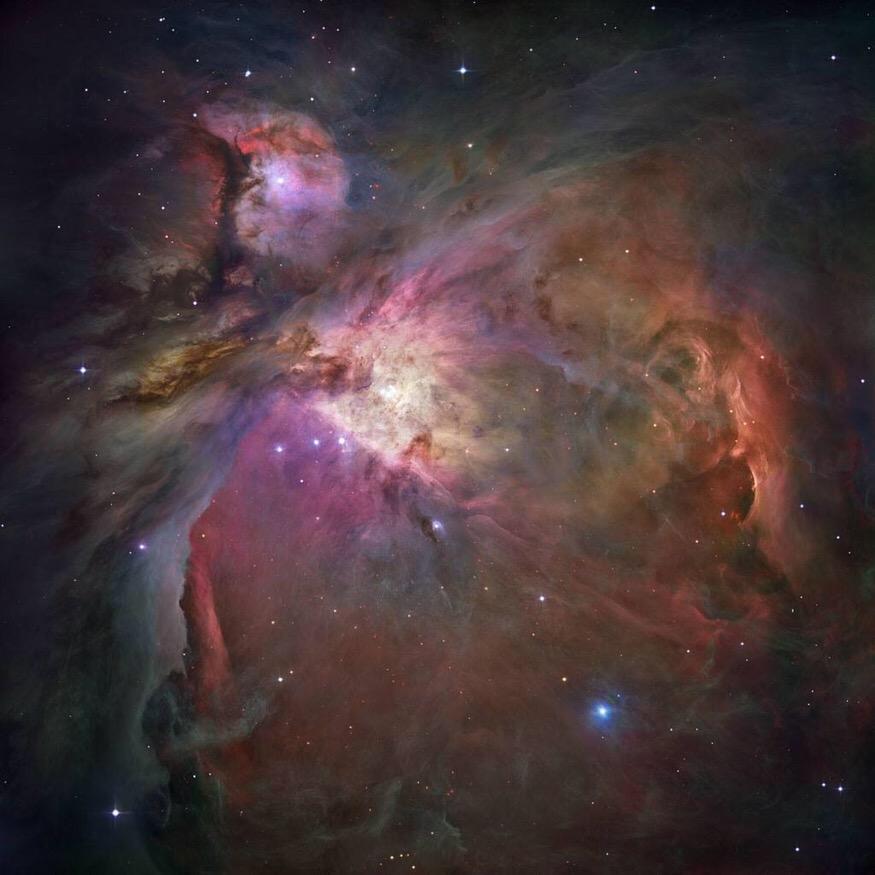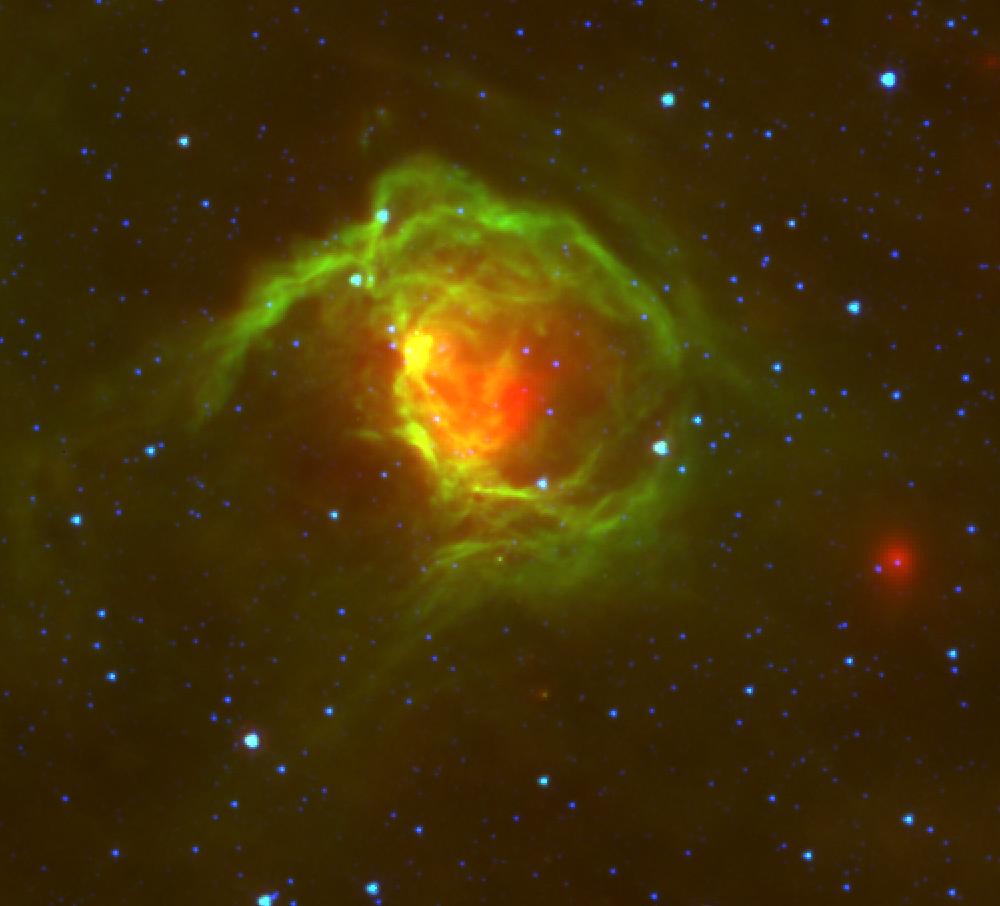Background
The most massive stars in the Universe also produce the most high energy photons. In fact, when you look at these stars in the night sky, they look blue - and blue light is more energetic than red light. These stars actually release most of their energy in the ultraviolet (UV) regime. The Sun produces UV photons as well, and this is what gives you skin cancer. Because our Sun is of rather average size, it doesn't produce much UV light compared to massive stars.
 Relative colors of stars. The blue stars are massive,
yelow stars like the Sun less massive, and red stars
the least massive. The top graphs show energy as a
function of wavelength. The energy from the bluest
stars peaks in the ultraviolet, and these are the
stars that create HII regions.
Relative colors of stars. The blue stars are massive,
yelow stars like the Sun less massive, and red stars
the least massive. The top graphs show energy as a
function of wavelength. The energy from the bluest
stars peaks in the ultraviolet, and these are the
stars that create HII regions.The UV photons from massive stars actually remove
electrons from the protons of hydrogen atoms, in a
process called "ionization." Ionization creates
a
We can see HII regions with our naked eyes on dark, clear nights. One example is the Orion nebula. This is the nearest bright HII region, but there are thousands in our Milky Way Galaxy. Every time we see an HII region there must be massive stars within it. For Orion, we can actually see these four massive stars as well. They are collectively known as the "Trapezium."

The Orion Nebula seen with the Hubble Space Telescope at optical wavelengths. The Trapezium is at the center. In this image the colors indicate ionized gas from the Trapezium stars. (Credit: NASA)
The location of massive stars (and HII regions) tells us an enormous amount about the Milky Way. All stars orbit around the center of the Galaxy. Massive stars do not live very long, so the place we find them is the place they were born - they do not live long enough to leave their birthplaces. We use HII regions to understand how the Galaxy is making stars today. To better understand the locations, environments, and number of stars our Galaxy is making, we need to find all the Galactic HII regions.
HII regions are extremely luminous and can be detected using light of various energies. The light that we can see is emitted at what we call "visible" or "optical" wavelengths. Although HII regions are bright at visible wavelengths, dust in the Galaxy limits the distance at which we can see them. To find HII regions across the entire Galaxy, we need to use telescopes that can see longer wavelength photons invisible to your eyes. This light is in what are known as the infrared and radio wavelength regimes.
 A multiwavelength view of our Milky
Way Galaxy. The center of the Galaxy is at the
center of each panel. Long wavelength emission
is on the top and short wavelength emission is on
the bottom. The dark patches in the optical
image are evidence for absorption by dust in our
Galaxy that limits the amount of light we can see
in some directions. (Credit:
NASA)
A multiwavelength view of our Milky
Way Galaxy. The center of the Galaxy is at the
center of each panel. Long wavelength emission
is on the top and short wavelength emission is on
the bottom. The dark patches in the optical
image are evidence for absorption by dust in our
Galaxy that limits the amount of light we can see
in some directions. (Credit:
NASA)We have discovered that all Galactic HII regions look
essentially the in the infrared. When the images are
properly made, HII regions have red emission from hot
dust grains surrounded by green emission from cooler,
smaller dust grains. We can therefore use infrared
images to identify





Once these regions are identified, we need to find out where they are in the Milky Way. The infrared data tell us the direction of each HII region, but we need one more piece of information in order to determine the true location: we need sensitive observations with the Green Bank Telescope (GBT).
 The Green Bank Telescope of
Pocohontis County, WV. This 100m diameter dish
is the largest steerable telescope in the world.
We use the GBT to detect faint radio waves from
distant HII regions.
The Green Bank Telescope of
Pocohontis County, WV. This 100m diameter dish
is the largest steerable telescope in the world.
We use the GBT to detect faint radio waves from
distant HII regions.The radiation we observe with the GBT is called radio recombination lines (RRLs). Rememeber how HII regions are ionized gas spheres and that ionized gas consists of free protons and free electrons? Sometimes those freen electrons find each other and like opposing magnets get (re)stuck together. When that happens sometimes the newly reformed atom is left in an energetic state, in that their electrons are in high orbitals. Atoms want to get rid of this extra energy, and they do so when the electrons decrease their orbitals toward the ground state. When they do this, energy is conserved, and radiation is emitted. The atoms lose energy, and the same amount of enery is emitted. We can detect this energy with the GBT.
 An illustration of the electron orbitals
for an atom. Emission line radiation is emitted when
the electrons transition from higher states down to
lower states. We can detect this radiation with
telescopes. This electron is transitioning from level
three to two. With the GBT, we will be detecting
transitions between very high levels, i.e., between
levels 93 and 92.
An illustration of the electron orbitals
for an atom. Emission line radiation is emitted when
the electrons transition from higher states down to
lower states. We can detect this radiation with
telescopes. This electron is transitioning from level
three to two. With the GBT, we will be detecting
transitions between very high levels, i.e., between
levels 93 and 92.What do these observations give us? Remember that everything rotates around the Galacic center? This rotation makes HII regions in some parts of the Galaxy move towards us, and some away from us? This motion toward or away from us causes the radio emission from the GBT to shift slightly, in what is called the Doppler effect. Depending on the magnitude and direction of this shift we can determine where the HII region lies in the Milky Way. We have observed almost 1000 Galactic HII Regions with the GBT as part of the HII Region Discovery Survey (HRDS), but we have a long ways to go. Below is a map of our current progress.
 Cartoon model of the Milky Way Galaxy,
with the locations of HII regions plotted on top.
With more GBT observations, we can begin to fill in
this diagram.
Cartoon model of the Milky Way Galaxy,
with the locations of HII regions plotted on top.
With more GBT observations, we can begin to fill in
this diagram.Where you come in is that we don't know what to observe! We have nearly 2000 HII regions in the Galaxy that we could look at, but not all of these can be detected by the GBT. Your job is to decide which of these 2000 regions we should observe. We will then observe them with the GBT to map out the structure of the Milky Way, and to better understand how massive stars are born.